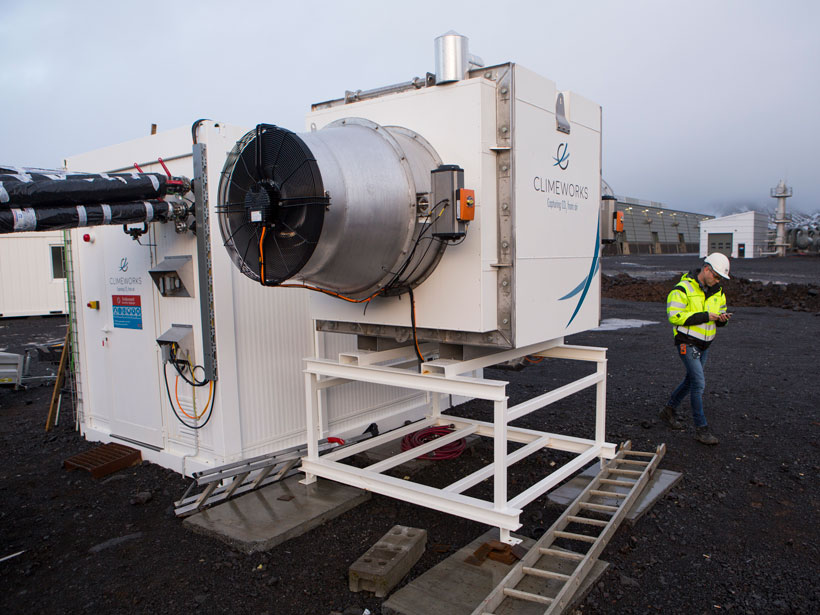When Jennifer Wilcox began researching the direct air capture of carbon dioxide (CO₂) about a decade or so ago, she was skeptical about how useful the technique could be. That was before climate models started including negative emissions to meet climate goals, she said.
“We traveled along the business-as-usual trajectory for far too long to get to choose what we want to do at this point,” Wilcox said about insufficient efforts to curb CO₂ and the need now to look into many different options. “Beggars can’t be choosers.”
“I thought, why would we ever consider doing this [direct air capture] when we should just really focus all of our efforts on avoiding carbon [emissions] in the first place?” said Wilcox, a professor of chemical engineering at Worcester Polytechnic Institute in Massachusetts. “We should be focusing all of our efforts on fuel switching, transitioning [to clean energy], increasing renewables, carbon capture and storage, [and] all kinds of things that are associated with avoiding carbon emissions in the first place.”
Now, however, Wilcox, the author of Carbon Capture, the first textbook on the subject, thinks that direct air capture should be considered as part of the overall mix to reduce emissions.
“We traveled along the business-as-usual trajectory for far too long to get to choose what we want to do at this point,” Wilcox said about insufficient efforts to curb CO₂ and the need now to look into many options. “Beggars can’t be choosers.”
Wilcox will present a talk at AGU Fall Meeting 2019 on “The Role of Direct Air Capture in Meeting Our Climate Goals” on Wednesday, 11 December, at 11:35 a.m.
Hopeful for Technological Advances and Lower Costs
A recent report, Negative Emissions Technologies and Reliable Sequestration: A Research Agenda, issued by the National Academies of Sciences, Engineering, and Medicine, describes direct air capture as “chemical processes that capture CO₂ from ambient air and concentrate it, so that it can be injected into a storage reservoir.”
Wilcox recognizes that direct air capture currently is a difficult, expensive, and energy-intensive process. CO₂ in the atmosphere, for instance, is about 300 times less concentrated than the CO₂ contained in the exhaust from a coal-fired power plant, which means that you need 300 times the contact area for direct air capture to sock away the equivalent amount of emissions, according to Wilcox.
“Energetically, cost-wise, it’s easier to go after the point sources,” Wilcox acknowledges. But she added that there is a need for direct air capture as well, and she and others are hopeful that technological advances could significantly lower the costs and the energy currently required for direct air capture.
Direct air capture has a “high potential capacity for removing carbon” but “is currently limited by high cost,” according to the report. Wilcox served on the committee that produced the report.
The report suggests a research plan that would include scaling up and testing air capture materials and components, as well as designing, building, and testing an air capture demonstration system. In addition, the report notes that some companies, including Carbon Engineering and Climeworks, are working on commercializing direct air capture systems.
The September 2019 Clearing the Air report by the Energy Futures Initiative, which is chaired by former U.S. energy secretary Ernest Moniz, calls for a 10-year, $10.7-billion U.S. federal research and development initiative for carbon dioxide removal technologies, including direct air capture, terrestrial and biological CO₂ capture, and other capture methods.
“Net-zero carbon dioxide (CO₂) emissions is not credibly achievable by midcentury without major contributions from negative-carbon technologies. Such technologies will also make possible, in the long term, a reversal of ever increasing greenhouse gas (GHG) concentrations in the atmosphere, thereby reducing the impact of past actions,” the report notes. Direct air capture, or DAC, “has a very large potential scale for CDR [carbon dioxide removal]. The overarching [research, development, and demonstration] objective for DAC is to reduce the cost and energy use and improve the performance and durability of DAC technologies to be a viable option for CDR.”
Not a Replacement for Avoiding Carbon in the First Place
Although Wilcox shied away from saying she is confident that direct air capture will be a real part of the solution to climate change, she said she is hopeful.
“I’m hopeful that it will be, because I don’t think we have any other choice,” Wilcox said, adding that other carbon capture methods also are important. “I’m hopeful that the subsidies will be put into place, and the policy framework will be put into place that will allow us to move forward with the deployment of negative emissions on a scale that will positively impact climate.”
“Negative emissions will not be a replacement for avoiding carbon in the first place.”
She added, however, that negative emissions are not a solution by themselves. She said that “climate math is hard” and there needs to be an understanding that “we really need to do everything” to deal with climate change. Wilcox cautioned, “Negative emissions will not be a replacement for avoiding carbon in the first place.”
—Randy Showstack (@RandyShowstack), Staff Writer
Citation:
Showstack, R. (2019), Direct air capture offers some promise in reducing emissions, Eos, 100, https://doi.org/10.1029/2019EO137553. Published on 10 December 2019.
Text © 2019. AGU. CC BY-NC-ND 3.0
Except where otherwise noted, images are subject to copyright. Any reuse without express permission from the copyright owner is prohibited.

